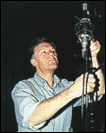
OPUS 3's PHILOSOPHY OF SOUND RECORDING
Jan-Eric Persson - Opus 3 Records

 |
OPUS 3's PHILOSOPHY OF SOUND RECORDING |
 |
Depth of Image So accustomed are we to three-dimensional vision, that we never really think about it. But we need only shut one eye for our judgement of distances to be reduced and our three-dimensional vision to disappear: we need both eyes and the relation between them in order for see three-dimensionally. Much the same is true of our hearing. Our brain and auditory system "process" the sound-waves reaching each ear, with regard to level, direction, time and frequency content. The signal is further "analysed" by our brain and auditory system, and the differences between signals coming from our two ears tell us, for example, about distance to the different sound sources and their relative positions. We experience “Depth of Image": for example, the different instruments of the orchestra in a concert hall are differently placed, not only from left to right but also in depth, together with the size and acoustics of the concert hall. By "collecting" the total sound at one single point with a stereo microphone -that is, a microphone with its capsules as close together as possible -we obtain a strict relation between the direct sound and the reflected sound (the diffused sound field), and this gives our brain and auditory system important information for building up an illusion of "reality" - the concert hall, the church or the jazz club. It is also very important for the direct and the reflected sound to have an exact acoustic connection with the sound-waves from each instrument. In traditional recording studios, there is, basically, one microphone (or sometimes even more) per instrument, and these are then mixed together electrically. This is not real stereo, it is just panned mono. Since, moreover, the microphones are usually placed very close to each instrument in an acoustically dead studio, all one gets is the direct sound of the instrument, and so artificial reverberation has to be "added on" electrically afterwards. Timbre By timbre we mean the specific character of an acoustic musical instrument - meaning, for example, what makes it possible for us to tell one instrument from another. The timbre of a musical instrument is a combination of its significant spectral distribution, i.e. the relation between notes and their harmonics and each relative level and frequency distribution, and last but not least, the way in which the sound-waves radiate from the body of the instrument. All our acoustic instruments are designed to be played in some form of concert hall, i.e. in a place where you hear both the direct sound of the instrument and the reverberation of the environment. If, like Opus 3, you are aiming for as natural an instrumental timbre as possible, it is vitally important that acoustic instruments can also be recorded in the type of surroundings they were originally designed to be played in, but also with longer microphone distances, so as also to capture the sound radiating from the whole sounding body of the instrument. The short microphone distances normally used also make the timbre unnatural, and so it has to be "restored" artificially, using various equalizers etc. We mustn't forget that when our acoustic musical instruments were created, a long time ago, neither electricity, microphones or recording studios existed! Dynamics The dynamic range of a musical instrument is the difference between the loudest and the softest sound level it is capable of producing. Like timbre, the dynamics of a musical instrument depend, not only on how it is built but also on how it is used by the composer and performer. Dynamics in this sense are used to create a large number and variety of musical effects, changes of emotion, mood and expression etc., etc. The dynamic properties of a musical instrument are also very much affected by the way in which it is recorded. The short microphone distances used for multi-microphone recording in traditional studios also exaggerate the recorded dynamics. Just like timbre, the dynamic balance then has to be artificially "restored", using compressors, limiters and so on. Discussions of sound nowadays tend to be very much preoccupied with the digital links of the sound reproduction chain, especially where gramophone recordings are concerned. Attention very often focuses exclusively on the type of A/D converter used, how many bits, the amount of oversampling, how the equipment is specially modified, and so on and so forth. When Opus 3 started at the end of 1976, there was far more talk about the way in which the actual recording was done purely in terms of recording technique or philosophy - that is, the methodology employed (multi- mike versus twin microphone technique etc.) and the type of recording situation chosen - natural environments or traditional studio technique, and so on. Whatever the technical apparatus, it is still the actual, recording philosophy that does most to decide what a recording will sound like - a fact which has been virtually lost sight of in the discussion of sound today. The quantity of electronics used in a recording is also highly important. In the type of mixer consoles commonly used in a studio nowadays, the acoustic signal passes through a very large number of amplifier stages - between thirty and forty or more is not unusual! The Opus 3 electronics, which are mainly tube-equipped and which we have partly developed ourselves, seldom include more than three of four amplifier stages between microphone and storage medium. Opus 3's recording technique has been specially developed for acoustic music and is based on using the natural acoustics of authentic environments such as churches, concert halls, jazz clubs and so on. We match the venue to the music, so to speak, as opposed to the common studio practice of adding an artificial reverberation afterwards and so on. The positioning of the microphone in the recording room and the positioning of the musicians in relation to the microphone are also extremely important. From the very outset we have used what is known as the coincident or X/Y recording technique, mainly employing the special configuration of crossed figure of eights, also known as the Blumlein technique, after Alan Dower Blumlein, the British radar engineer who developed the technique way back in 1934. Jan-Eric Persson - Opus 3 Records |
Thank you for visiting
our Opus 3 catalogue on the Rockian Trading web site.
New releases will be added as they become available.